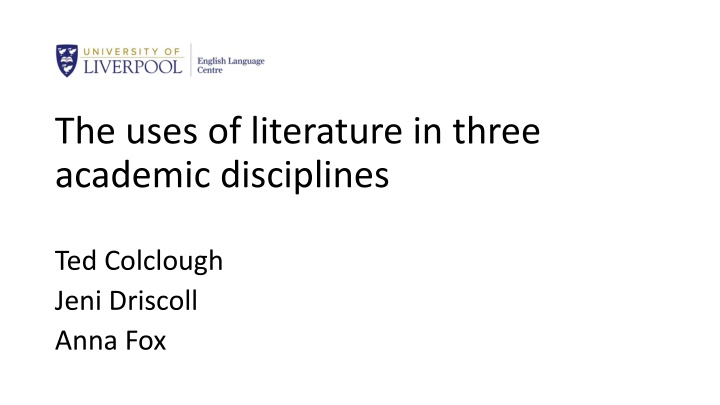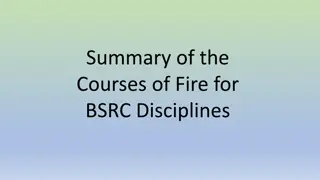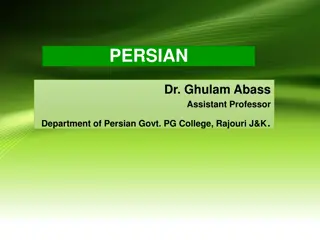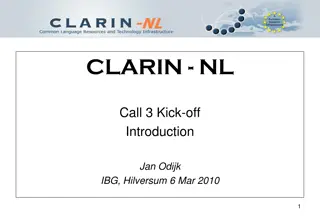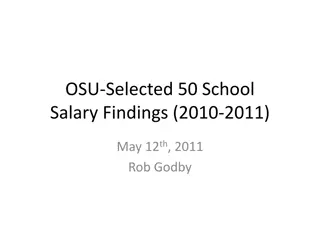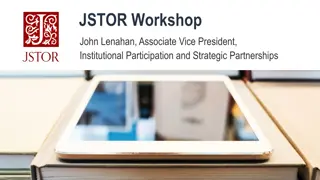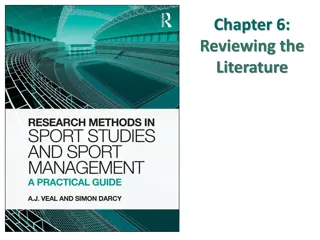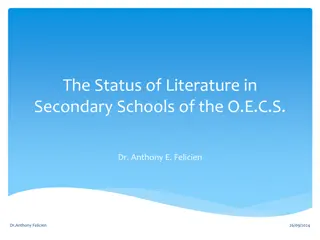The Role of Literature in Academic Disciplines: Insights from Finance
Explore how literature is used in the finance discipline, focusing on theoretical analyses, empirical investigations, and testing theories in the real world. Understanding existing literature helps in classification, familiarity, and replication, essential for advancing knowledge in finance.
Download Presentation

Please find below an Image/Link to download the presentation.
The content on the website is provided AS IS for your information and personal use only. It may not be sold, licensed, or shared on other websites without obtaining consent from the author.If you encounter any issues during the download, it is possible that the publisher has removed the file from their server.
You are allowed to download the files provided on this website for personal or commercial use, subject to the condition that they are used lawfully. All files are the property of their respective owners.
The content on the website is provided AS IS for your information and personal use only. It may not be sold, licensed, or shared on other websites without obtaining consent from the author.
E N D
Presentation Transcript
The uses of literature in three academic disciplines Ted Colclough Jeni Driscoll Anna Fox
Finance the nature of the discipline Applied microeconomics one of the most quantified and theorized disciplines in the business curriculum. Facing an enormously complex real world, we have to have a device to capture the essence of various events by abstracting from reality via a theory. A theory is an attempt to give reasons for some observed regularity among things that are complex and often changing.
explanations and predictions are the main goals in finance. To this end, both theoretical analyses and empirical investigations are necessary As theories provide guides for empirical studies and empirical studies provide tests of the assumptions and conclusions of theories, they are complementary. (Chang, 2005)
Finance a typical task Testing to what extent a theory holds in the real world. Structure: theory data methodology significance Sometimes it s you have to know the data; sometimes it s you have to know the techniques; sometimes you have to know the theory; sometimes you have to know all of them.
Finance uses of literature Familiarity Classification You have to read the existing literature. Once you re in your comfort zone in the existing literature, you can then, for example, classify the literature according to the assumptions that the various authors make or you can classify the literature according to the data that they use, the theories they employ, and that gives you then angles where you can look at either oversights or omissions or errors But in order to do this, you have to have a command of the existing literature. Now there s two aspects to that then. One is what s the kind of theoretical end of the literature saying and the other is what is the empirical literature saying, so what is the evidence.
They basically go to the library, pull a paper and replicate it and you hope that they don t plagiarise the literature survey.
Motivation and contribution I would start by motivating what I m doing in the context of what has gone before. Quite often I ll start with a question, OK?... I can then argue I m making a contribution to knowledge, so given the existing weaknesses in the literature, here s what I m doing. If somebody hasn t done a literature review then they may spend three or four months reinventing the wheel, right, and there s nothing in it. That s very annoying when you see that going on.
Stance I m an empiricist so typically I will try and let the data tell me what my stance is and to do anything else would be incorrect. Now, a theorist may go in with a pre-assumed position, but I wouldn t want to establish my stance. That s known as bias, which is very bad if you re doing empirics because you want unbiased estimates. There s an almost one hundred percent correlation between in my opinion and low scores. Right? Erm, a student can include their views but it should be on the basis of the evidence, right, and on the balance of the arguments in the literature.
Critique You never get any critique. In four years here I have seen one dissertation with any critique.
Engineering Engineering the nature of the discipline the nature of the discipline Learning to apply fundamental scientific knowledge to solve problems or as the basis for the design of new products, processes and systems. I sum it up as CDIO conceive, design, implement and operate, so invent, make, supply, operate and then dispose of at end of life, they re the phases of engineering; so from someone s mind into reality into use and recycled.
Engineering the nature of the discipline A core of established science It tends to be the older stuff where there s consensus. Cutting edge developments on the periphery New stuff [is] being added all the time some turns out to be unsubstantiated, but most [is] just addingto what is the set of tools, techniques, materials that engineers have Always at the edges in developmental engineering, at the cutting edge of science there will be different camps having different views...
Engineering typical tasks Writing about Writing about DESIGNS EXPERIMENTS (Product Design Specifications) Identify a need/opportunity Understand the requirements/user needs Generate/explore various concepts Evaluate concepts -> select 1 Develop/refine the selected design IMRD structure: Introduction Method Results Discussion
Engineering - uses of literature Familiarity They have to demonstrate as a student that they know the underlying science. Might not always need to do that as a professional, it s probably taken as read, but they have to demonstrate it so that they can get some marksfor that. Motivation & contribution So the first type of literature will be the things that establish the sector or problem or need not necessarily scientific, might be social science or might be medical or any of the sectors that engineers serve. You d like to think that if they ve done the scientific research and have come out with some findings, you d like to think in their closing sections they would refer back to some of the literature. They never do.
Engineering - uses of literature Analysis & application They ve got to put these [sources of information] together. They need to understand standards [i.e. British standards or international standards], have to understand any [relevant] rules, regulations, laws, policies, procedures . The hardest thing for them to get is so-and-so [referring to a source] says that, so-and-so says that, and so-and-so says that and the way that s relevant to me is this .
Engineering uses of literature Critique & stance about the design project, they ve got different design ideas that have come from within the team and they will critically review those. [W]here their voice comes in much more is evaluation of their own ideas and their own developments and where they justify their route from millions of concepts to one thing their interpretation of situation information to create a product. They do it partly by matrix analysis, concept variant analysis, where they set the criteria against which they re going to measure their ideas, and they weight them it s like a number at the end - it s that one! But of course it has to be followed up with an argument. They have to argue for the selection of concepts. We chose an electric over a diesel engine for these reasons. And this is completely new to them. It s the first time they ve ever done it in Y2.
Architecture the nature of the discipline you can't just work in architecture and make buildings in isolation. It was always the case that architects were working in relation to society, in relation to their context but in general architecture in universities there's problems with their traditional models. the influence of architecture comes from the architecture out to society it doesn't work the other way round, ok. The content of architecture, the buildings as well as the goals, the ideas and ideals of a field are increasingly impacted by an awareness of the social roles, which is having enormous consequence for architecture and for dissertations.
Architecture the nature of the discipline PGT Programme Qualification specialism MA Architecture specialise in architectural design Master of Architecture validated by RIBA and prescribed by ARB as a Part II qualification towards access to the Architectural Profession in Europe MSc Building Information Modelling (BIM) integrated and efficient approach to design and construction that builds on both architectural knowledge and technological progress MScDigital Integrated Design technology-mediated design theories, methods and techniques in Architecture and Urban design the integration of digital media in architectural and urban design MSc Sustainable Environmental Design in Architecture (SEDA) designing for climate change, sustainable architecture, low carbon technologies and computer modelling of sustainable environments
Architecture a typical task ??? studio presentations & critiques seminar paper abstracts seminar presentations (to postgraduate students and tutors) seminar presentations (to wider audience within the School of Architecture) illustrated architectural journal articles academic posters research proposals dissertation
Architecture a typical task: the dissertation MA and MSc students have three options: A written dissertation (10,000 words) Design [thesis type] Project Research by Design Project (5,000 words)
Architecture a typical task: the dissertation Aims: to explore an aspect of architecture (and closely related fields, such as Urban Studies, Planning, Art, Computer Aided Design, etc.) systematically and in detail, and to present their findings in an academic way to submit a conventional written dissertation OR to submit a design thesis with supporting documentation on an approved topic or brief of their choice which responds to current research agendas in the field of architecture, and in particular the idea of Design as Research
Architecture a typical task: the dissertation Well, because architecture has this sort of funny situation Master of Architecture fully fledged MArch architect ? academic dissertation
Architecture a typical task: the dissertation new categories of traditional model of research scholarship Boyer & Mitgang (1990)
Architecture a typical task: the dissertation The debate on the relationship between research and design is continuous and complicated. For architectural education one of the key goals set in order to benefit students was that of a unified profession; seeking closer collaboration and understanding between the academy and the architectural profession. Piatkowska (2016) Design activity is sometimes regarded as less scholarly Boyer & Mitgang (1996)
Architecture uses of literature Motivation defining the problem to be investigated - requires considerable thought and a commitment to reading an aspect of architecture, history, urbanism, society, construction, procurement, cities almost anything that relates to our built environment to generate new understandings, findings, data and interpretations we want you to contribute to the body of knowledge, or provide new interpretations and understandings of the existing body of knowledge. This will be manifest in different forms depending on the course you are taking.
Architecture uses of literature Contribution it is also for the construction of truth, knowledge and information that might then be applied as or developed into policy, collections, products, systems, or simply collated for its own end
Architecture uses of literature Reading is the key event research content and research methods Sources: sources/data that have not been previously published; e.g. interviews, surveys, archival data, correspondence, fieldwork. You can conduct very insightful surveys, literature reviews and analysis from existing research/books/datasets maps, diagrams and illustrations, timelines, building plans and photographs to produce and then discuss own drawings and surveys
Architecture uses of literature Butterfly collecting Carefully organise your data and think about how it can be arranged, catalogued and displayed. I call this bit butterfly collecting . In essence you are gathering and cataloguing, putting things into an order and creating a taxonomy. Some students stop at this point but the better scholars continue and try to analyse and interpret this material what does it all mean? How does it fit into a larger canon and body of knowledge? How does it confirm or contradict how we have previously thought about the subject/style/person/society?
Architecture uses of literature Stance My problem is which is your problem , is to help students do what they want to do. I don't want to tell them that topic is too complicated I want them to do what they want to do and to feel happy about it and if I can do it in a scientific framework, everybody's doing what they want to do. Familiarity skills and knowledge I try to get the students to ensure that they re able to in a dissertation show that they are skilled in the practical and the grounding roots. The literature review is important there, ok, because you must provide your students with the most fundamental literature. You can t tell them they re supposed to read around.
Conclusions nature of the disciplines hard, soft, pure, applied (Becher and Trowler, 2001) inter/multi-disciplinarity social context purpose of discipline nature of the discipline the point I'm trying to make is the very fact that you're doing these interviews suggest that you re questioning whether the disciplines are definitive. sometimes hard to separate out nature of the discipline and use of sources
Conclusions literature / sources / data disciplinary knowledge (or lack of) and implications for discipline- specific EAP common criticism from tutors and departments - all description and no critique what is meant/understood by criticality ? the role and use of sources process and product relationship between EAP writing and reading assumptions about reading skills and materials next steps
References Becher, T. & Trowler, P.R. (2001) [2nd Ed] Academic tribes and territories: Intellectual Enquiry and the Cultures of Disciplines. Buckingham: OUP. Boyer, E.L. & Mitgang, L.D. (1990) Scholarship reconsidered: Priorities of professoriate. Princeton, NJ: Carnegie Foundation for Advancement of Teaching. Boyer, E.L. & Mitgang, L.D. (1996) Building community: A new future for architecture education and practice. Princeton, NJ: Carnegie Foundation for Advancement of Teaching. Chang, S.J. (2005) A critical discussion on financial theory: what should we teach and how? Journal of Economics and Finance Education. 4(2) pp 39-48. Piatkowska (2016) Moving towards competence in teaching architecture: the relationship of research and design in academia Procedia Engineering 161 (2016) 1476 1481.
